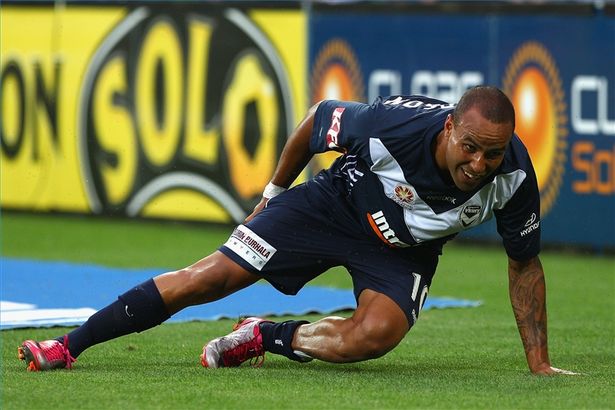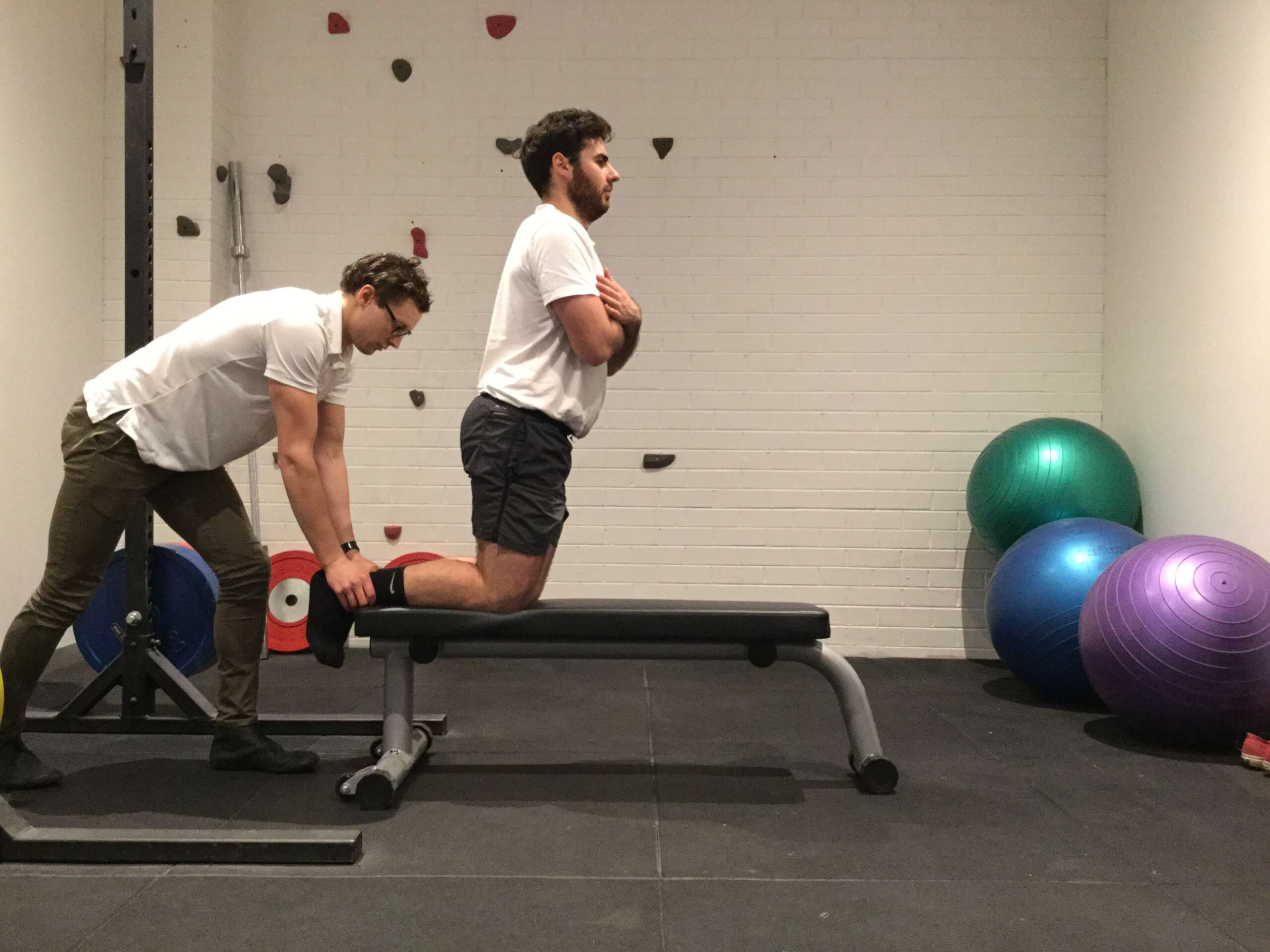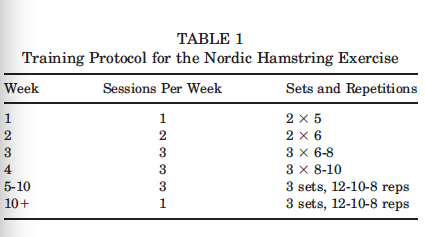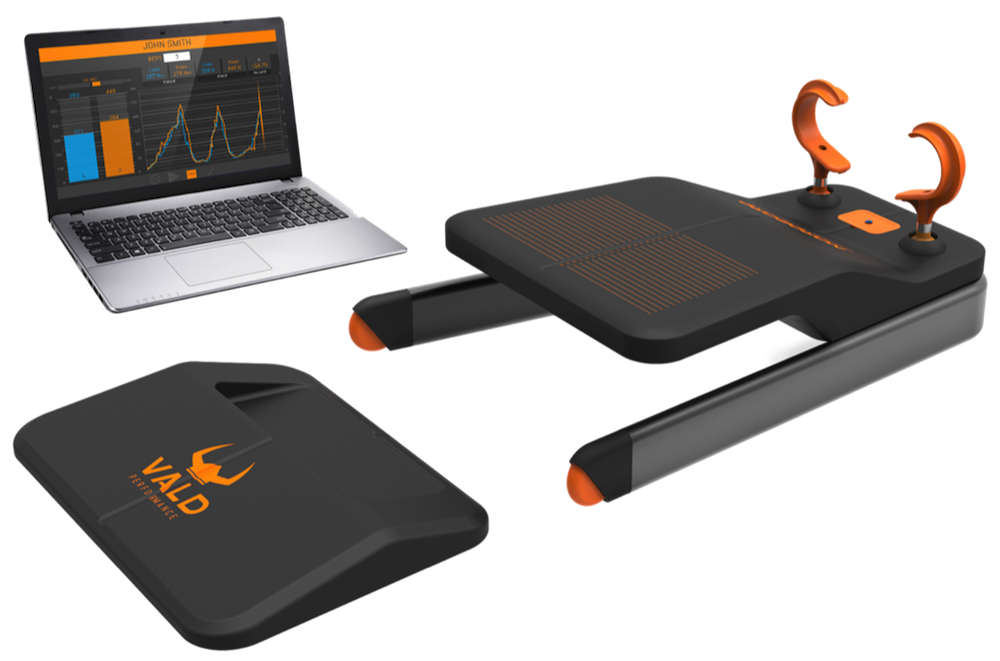Hamstring Strain Injuries (HSI) are one of the most common injuries sustained in team sports. HSI are the most common muscles injury in professional soccer, accounting for 37% (Ekstrand et al., 2011) and is the most common injury in AFL football (Orchard et al., 2011). It was predicted that in 2012 each individual HSI cost the AFL $40,021 (Hickey et al., 2014). Many protocols have been used to help prevent the risk of HSI, but none have been studied more than the humble Nordic Hamstring Curl (NHC). Let’s have a look at what it actually is and what the research says about it.
What is it the Nordic Hamstring Curl?
The exercise is normally done with the help of a partner. The person performing the exercise kneels down on an elevated surface (such as a bench or board) keeping their back straight with their toes pointed upward towards their knee. The partner stands or kneels behind the participant holding both their ankles with each hand tightly so that they do not fall. The exercise participant then lowers themselves down slowly as far as they can, pivoting at the knees. When they cannot control their body any longer, their arms should come up into a push up position to catch themselves before they hit the ground. The participant can also use Recommend the push-up position to help initiate the movement back to the starting position.
This exercise is much harder than it looks and requires you to activate your hamstrings very strongly. order tramadol online mexico https://99percentinvisible.org/ cheap tramadol online prescription This exercise can also be done solo, through the use of bands.
The Research
One of the catalysts for the growth in research on the potential for NHC to prevent HSI was a paper by Askling et al. (2013) entitled ‘Hamstring injury occurrence in elite soccer players after preseason strength training with eccentric overload.’ The researchers took 30 elite Swedish soccer players and randomized them into two groups. one group underwent two weekly sessions of hamstring strengthening (in the form of a prone hamstring curl machine completing four sets of eight repetitions) the other group had no extra training. They followed the two groups over 10 months and at the end of that period the hamstring exercise group sustained 3 injuries, while the control group experienced 10 injuries. Furthermore, the hamstring training group experienced increases you in both speed and strength.
Then came the landmark paper by Peterson et al. (2011). The study was able to attract 942 male soccer players to take part. The participants were randomised into two groups and were monitored for an entire soccer season. The intervention group performed 27 sessions of the NHC in the first 10 weeks and then once per week for the rest of the season. The control group did nothing extra on top of their normal training. When the two groups were compared at the end of the season, the control group suffered 52 acute hamstring injuries whereas the intervention group suffered only 15 injuries. Another interesting point was that the likelihood of recurrent HSI was 45.8 percent in the control group and just 7.1 percent in the intervention group. The NHC intervention reduced overall, new and recurrent hamstring injuries.
 Peterson et al. (2011) NHC Training Program
Peterson et al. (2011) NHC Training Program
A similar randomised control trial by van der Horst (2014) found parallel results to the previous Peterson et al. (2011) study. They randomised two groups of approximately 300 soccer players and found that the group who performed the NHC suffered 11 HSI, while the control group suffered 25 HSI. Interestingly though, the authors noted that NHC intervention did not significantly change the severity of HSI in either group.
Current and Future Applications
The Nordic Hamstring Curl’s current main application is to screen and monitor athletes to see if they are at risk of HSI. A study by Opar et al. (2014) took 210 elite AFL players and monitored their eccentric hamstring strength in the form of a Nordic Curl at three points during the season. The study illustrated that eccentric hamstring strength below 256 Newtons at the start of the preseason increased the risk of HSI by almost three-fold 2.7-fold and eccentric hamstring strength below 279 Newtons at the end of pre-season increased the risk by 4.3 fold. The study detected no increased risk of injury for differences in hamstring strength between left and right. Finally and perhaps most interestingly, it is known that increasing age and previous hamstring injury are risk factors for HSI and this study showed that eccentric hamstring training can reduce the risk of HSI in both at-risk groups.
The practical application of these studies is to monitor all athletes in team sports at various stages of the season as a preventative strategy for HSI. This method is already been used at many AFL clubs. The Opar et al. research group have developed a device they call the ‘Nord Bord.’ It is a Nordic Hamstring Curl device that is connected to a cloud-based software so that team medical staff can monitor the risk of HSI throughout the season. This seems like a fantastic device that will hopefully help reduce the shockingly high amount of hamstring injuries in team sports.
 The ‘Nord Bord’
The ‘Nord Bord’
Personally, I would like to see this kind of research extrapolated to other hamstring exercises. For instance, a deadlift training intervention in a group of team sport athletes could be monitored through the use of the Nord Bord device. The researchers could use the Nord Bord to monitor changes in strength and injury rates could be compared to a control group and further referenced against the RCT’s using the NHC.
Overall, the NHC is a fantastic injury prevention exercise with a robust set of data to support it. I am very keen to see where HSI prevention research and indeed all muscle injury prevention research goes in the future.
Thanks for reading,
Nick
About the Author:
Dr. Nicholas Tripodi is a Co-director and Osteopath at the Competitive Sports Clinic located in the Essendon District. Nicholas has particular interests in sports injuries, exercise rehabilitation and running and cycling analysis.
For more information, also check out our article on 7 ways you can get out of your football pre season program.
References
Askling, C., Karlsson, J., & Thorstensson, A. (2003). Hamstring injury occurrence in elite soccer players after preseason strength training with eccentric overload. Scandinavian journal of medicine & science in sports, 13(4), 244-250.
Ekstrand, J., Hägglund, M., & Waldén, M. (2011). Epidemiology of muscle injuries in professional football (soccer). The American journal of sports medicine, 39(6), 1226-1232.
Hickey, J., Shield, A. J., Williams, M. D., & Opar, D. A. (2014). The financial cost of hamstring strain injuries in the Australian Football League. British journal of sports medicine, 48(8), 729-730.
Orchard, J., & Seward, H. (2002). Epidemiology of injuries in the Australian Football League, seasons 1997–2000. British journal of sports medicine, 36(1), 39-44.
Opar, D. A., Williams, M. D., Timmins, R. G., Hickey, J., Duhig, S. J., & Shield, A. J. (2015). Eccentric hamstring strength and hamstring injury risk in Australian footballers. Med Sci Sports Exerc, 47, 857-65.



 Peterson et al. (2011) NHC Training Program
Peterson et al. (2011) NHC Training Program The ‘Nord Bord’
The ‘Nord Bord’